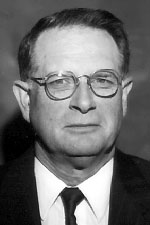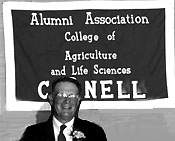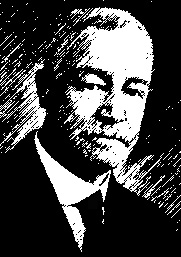 |
Biographical Notes
on
NYS Correctional Commissioners since 1878 |
 |

Philip Coombe Jr.
|
|
Philip Coombe Jr. served as Acting NYS DOCS Commissioner from August 1994 to April 1996.
He was a recipient of the 1996 Outstanding Alumni Award of the Alumni Association of the College of Agriculture and Life Sciences at Cornell University. The citation accompanying the award read:
"Philip Coombe Jr. (Class of) '58, Grahamsville, N.Y. Known for his long working hours with the corrections system, Coombe still has found time to help run a 1,200-acre beef farm with his brother, former State Assemblyman Richard Coombe '64, near Grahamsville."
Coombe retired in April, 1996, after 37 years with the State Department of Correctional Services. The Acting Commissioner was understandably proud of the fact that he had risen from an entry-level position to the department's top office, then the only person to have accomplished that.
Another point of personal satisfaction was the fact that shortly before he retired, DOCS had achieved 100 percent American Correctional Association accreditation for the state's then 69 correctional facilities. New York was the first state to achieve that status.
In 1959, Philip Coombe, Jr. was hired as a teacher at the Eastern Correctional Institution. He later became a counselor position and still later a superviser at the Woodbourne Rehabilitation Center. In 1977, Coombe opened a new DOCS facility in Otisville.
In 1980, he returned to Eastern where he had started 21 years earlier. Two years later, under his innovative leadership, Eastern became the first NYS correctional facility to be accredited by the ACA. Still later he moved on to Albany as Deputy Commissioner.
Coombe was known for his 80-hour work weeks with the corrections system yet helped run the beef farm and remain active in the community, participating as a member of the Tri-Valley Lions Club, the Ellenville Noonday Club and the Neversink Agricultural Society.
In 2001, Sullivan Renaissance Beautification Project award a $20,000 first prize in a summer-long beautification competition to Philip Coombe, Jr. and Neversink for the beautification of 21 miles and 27 enhancement projects in the area.
Coombe said the money would be put towards a new addition for the Daniel Pierce Library in Neversink.
“When things started looking better it became infectious,” Coombe said. “Everybody pitched in.” Coombe said he had 1,691 volunteers that helped out.
Neversink, second-oldest town in Sullivan County, is home to the Neversink Reservoir that provides New York City and parts of Westchester County with their water supply.
Awards seem to run in the family. In 1996, brother Richard I. Coombe, the chair of Watershed Agricultural Council, received the Environmental Action Council's Green Star Award for "serving national spokesman and advocate for urban-rural partnerships and for voluntary programs to achieve sustainable, environment-friendly agriculture and forestry."
An active CALS alumnus, Coombe has served as chair of a fundraising program to equip the Sullivan County Cornell Cooperative Extension Center and as extension enrollment committeeman. His wife and four children are all Cornell graduates.
The Coombe family was originally from New Jersey. His grandfather had been pastor of the First Presbyterian Church in Arlington, N.J. but often preached at the Reformed Church in Grahamsville, N.Y. where his grandmother had family. On July 2, 2002, Philip Coombe Jr.had the pleasure of diving his 100-year-old aunt Helen "in a sparkling white 1957 Chevrolet ragtop" to a Grahamsville's celebration of her centennial.
|

Philip Coombe Jr. at
the 1996 awards banquet of CALS Alumni Association of Cornell University.
|
These notes are not presented as official nor full portraits but as brief biographical references, outlines and sketches of some who have led the successive agencies that operated the state's prison system during the last 125 or so years.
Note #2
Among significant correction history developments in which Austin Lathrop played key roles during his 11 years (5/11/1887 - 3/08/1898) as Superintendent of the State Prisons Department, two in particular stand out:
- the first use in the world of the electric chair as the means of state execution in capital cases, and
- establisment of a state bureau of criminal identification.
Lathrop Buys 3 Electric Chairs
Lathrop's involvment with the electric chair came about as a result of Gov. David B. Hill signing on June 4, 1888, legislation that made electrocution the method of carrying out death sentences for crimes committed after January 1, 1889.
The legislation had emerged from increasing public concern that hanging was not a humane method of execution. Death penalty opponents had siezed upon certain horrific hangings to generate growing support for abolition of capital punishment entirely.
Gov. Hill wanted to keep the death penalty but recognized the groundswell of revulsion against hanging as the method of execution. In 1886, he had a commission study more humane methods.
The "New York State Commission to Investigate and Report the Most Humane and Practical Method of Carrying into Effect the Sentence of Death" on Jan, 17, 1888, recommended electrocution as the most scientifically humane means. The following April both houses of the state Legislature adopted the Electrical Execution Act replacing hanging with electrocution, effective the next Janauary.
The new law did not decide specifics such as which kind of current to use, direct (DC) or alternating (AC), or how much voltage to apply for how long a period. Such matters were left to the New York Medico-Legal Society. It set up a committee to research and resolve those question.

|
A sketch of Harold P. Brown,
with whom Superintendent Lathrop arranged for the design and installation of NY's first three electric chairs. |
Named to head the Medico-Legal committee was Dr. Frederick Peterson. He had a professional relationship with inventor Harold P. Brown, having assisted him in electrocution research on animals at Columbia College School of Mines. Brown, who had invented a DC-dependent device, was an ally of Thomas Edison in promoting DC as the "safer electricity."
Brown sought to have George Westinghouse's AC viewed by the public as the "killer current." Having the electric chair wired for AC fit that purpose quite nicely. By the time (December, 1888), the Medico-Legal Society recommended an AC-wired chair be used, Brown -- ever the self-publicist -- had established himself in the public eye as the leading technical "expert" on AC-electrocutions.
The Electrical Execution Act left the practical aspects of its implimentation -- such as construction of the chair, layout of the execution chamber, purchase and installation of equipment, and the executions themselves -- up to the Prisons Department.
On March 20, 1889, Brown met with State Prisons Supintendent Lathrop and the wardens of Sing Sing, Auburn and Clinton prisons to discuss equipment acquistion and funding questions. Lathrop authorized Brown to install fully operational electric chairs at the three prisons (that is, the chairs plus their power generating equipment) but would not advance funding to purchase materials. Brown would be paid only if his setup worked in an actual execution.
With Edison's help, Brown was able to find the necessary financing and connections to obtain three Westinghouse dynamos, through roundabout means despite George Westinghouse's efforts to prevent any such equipment coming into Brown's possession for that purpose.
In May, 1889 three events took place revelent to emergence of the electric chair as a method of state execution:
- Superintendent Latherop participated in the state firming up with Brown the agreement of the previous March between Lathrop and Brown. The next day the three dynamos were purchased.
- William Kemmler of Buffalo became the first person sentenced to die by state electrocution. He had been convicted of axing to death his common law wife Tillie.
- Kemmler was sent to Auburn Prison to await the sentence being carried out.
The actual execution took place Aug. 6, 1890 after various delays resulting from legal challenges fostered by Westinghouse wanting not to have his company name associated with electrocutions.
Although Lathrop was not listed among the execution witnesses, there can be little doubt he was very much a presence in the sense that Auburn Warden Charles F. Durston would have checked with the Department Superintendent on major preparation decisions.
Lathrop Starts State criminal ID Bureau
In 1893, seeking to solve the problem of accurately identifying, and thereby appropriately incarcerating, recidivists, State Superintendent of Prisons Lathrop sent his Chief Clerk, Charles K. Baker, to study the Bertillon System in Paris and London. On his return to New York, Baker brought back a copy of the second edition of Bertillon's System manual, published that year in France. The book, written in French, was forwarded for translation to Major R. W. McClaughry, the Illinois State Penitentiary warden who in 1887 introduced the system in the United States.
French ethnologist Alphonse Bertillon, who invented the identification system, had offered to the Paris Prefecture of Police but that civil servant promptly ignored the new idea. Not until the latter's retirement and the arrival of a new Prefecture did the Bertillon's proposal get any real review. It was adopted by the Paris Police in 1882 and soon thereafter by authorities in the rest of France and around the world, becoming the international standard.
The Bertillon System involved measuring certain bony portions of the head, trunk and limbs. These, along with hair and eye color, and front and side view photographs, were recorded on cardboard forms 6.5 x 5.5 inches. Using small, medium and large groupings, Bertillon created 243 distinct measurement categories. Eye and hair groups provided additional catgegories.
Lathrop had Baker begin the system in the state's prisons. Florence de Forest was hired on June 28, 1893, as Bertillon System card indexer under Baker's supervision. Later, Baker, de Forest and another clerk Frederick Hicks Duel designed the office that would hold the Bertillon files.

The first criminal identification card filed by the New York State Bertillon Bureau. |

For more New York criminal identification bureau history, read on this site NYCHS' 6-page excerpts presentation of the Division of Criminal Justice Services' 50-page web version of the
Origins of the New York State Bureau of Identification
by Michael Harling. It links to the full version at DCJS' site. |
What Lathrop had begun on his own authority as Prisons Superintendent was formally codified into law on May 9, 1896, when legislation passed authorizing the recording and filing of measurements of all inmates "confined or hereinafter received under sentence in the various State Prisons, Reformatory and penitentiaries."
Thus was the Bureau of Identification thereby created within the State Department of Prisons. Though not the first Bertillon bureau in the U.S., this has come to be regardedi as the first legislatively established bureau of criminal identification in the country. It was set up in Room 111 of the New York State Capitol building. But implementation of the innovation was not without problems.
Superintendent Lathrop noted in his 1896 annual report that the introduction of the Bertillon System was, due to its being "new and poorly understood," greater than either the Department or the Legislature had originally projected.
Classes to teach Bertillon measuring, classifing, recording, photographing and indexing were set up at Sing Sing Prison on July 15, 1896. The actual processing of 8,000 inmates was officially begun Sept. 1.
After its first year of operation, 131 "first offenders" were uncovered as having prior records. As a result, their sentences increased. Lathrop claimed New York inmate intake numbers declined while such numbers in neighboring states rose. He credited that reputed development to the system's reputation for finding repeat offenders among New York's incoming inmate population. The Superintendent suggested that the system tended to discourage ex-cons from engaging in crime in this state because, if arrested here, their priors criminal convictions were more likely to be uncovered even if they had tried to establish different identities.
Lathrop urged the Legislature to expand the bureau and use of the Bertillon System.
What Superintendent Lathrop could not foresee is that the bureau's future would be linked not to Bertillon body measurements but to ink pints from finger tips. The Department would not begin fingerprint experiements until 1903 during a successor's administration.
Go to
Biographical Note #1 on NYS Correctional Commissioners: the 1st -- Louis Dwight Pilsbury; the current -- Glenn S. Goord
| |